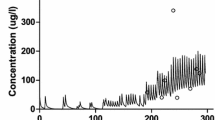Summary
There is growing evidence that renally-impaired patients receiving morphine therapy are at greater risk of developing opiate toxicity, due to the accumulation of an active metabolite, morphine-6-glucuronide (M6G), which is usually excreted by the kidneys. This study examined the relationships between morphine dosage, renal function, and trough plasma concentrations of morphine and its glucuronide metabolites in 21 patients (aged mean: 68.5 years; 11 males) receiving either oral or subcutaneous morphine for terminal cancer pain. The median daily morphine dosages (mg · kg−1) were: orally 1.87 (range 0.37–6.82) and subcutaneously 1.64 (range 0.22–3.60).
The median plasma concentrations of morphine, morphine-3-glucuronide (M3G), and M6G (ng · ml−1) were: 36.0, 1035.2, and 142.3, respectively. The plasma concentrations of morphine, M3G and M6G were each significantly related to the daily morphine dosage (n=21, Spearman r=0.79, 0.91, and 0.88 respectively). Accumulation of the morphine glucuronides was dependent on renal function. The plasma concentrations of M3G and M6G, when divided by the morphine concentration, were significantly related to the caluclated creatinine clearance of the patient. Patients receiving oral morphine had higher plasma concentration ratios of glucuronide/morphine than those receiving subcutaneous therapy, presumably due to first-pass glucuronidation.
The results of this study confirm that accumulation of the pharmacologically active M6G is related to renal function, which probably explains the observation that morphine dosage requirements are generally reduced in patients with renal impairment.
Similar content being viewed by others
References
Abbott FV, Palmour RM (1988) Morphine-6-glucuronide: analgesic effects and receptor binding profile in rats. Life Sci 43: 1685–1695
Chan GLC, Matzke GR (1987) Effects of renal insufficiency on the pharmacokinetics and pharmacodynamics of opioid analgesics. Drug Intell Clin Pharm 21: 773–783
Cockroft DW, Gault MH (1976) Prediction of creatinine clearance from serum creatinine. Nephron 16: 31–41
Crotty B, Watson KJR, Desmond PV, Mashford ML, Wood LJ, Colman J, Dudley FJ (1989) Hepatic extraction of morphine is impaired in cirrhosis. Eur J Clin Pharmacol 36: 501–506
Hoskin PJ, Hanks GW (1988) The management of symptoms in advanced cancer: experience in a hospital-based continuing care unit. J Roy Soc Med 81: 341–344
Osborne RJ, Joel SP, Slevin ML (1986) Morphine intoxication in renal failure: the role of morphine-6-glucuronide. Br Med J 292: 1548–1549
Osborne R, Joel S, Trew D, Slevin M (1988) Analgesic activity of morphine-6-glucuronide. Lancet I: 828
Patwardhan RV, Johnsson RF, Hoyumpa A, Sheehan JJ, Desmond PV, Wilkinson GR, Branch RA, Schenker S (1981) Normal metabolism of morphine in cirrhosis. Gastroenterology 81: 1006–1011
Poulain P, Hoskin PJ, Hanks GW, AlSayed-Omar O, Walker VA, Johnston A, Turner P, Aherne GW (1988) Relative bioavailability of controlled release morphine tablets (MST Continus) in cancer patients. Br J Anaesth 61: 569–574
Regnard CFB, Twycross RG (1984) Metabolism of narcotics. Br Med J 288: 860
Sawe J, Dahlstrom B, Paalzow L, Rane A (1981) Morphine kinetics in cancer patients. Clin Pharmacol Ther 30: 629–635
Sawe J, Svensson JO, Rane A (1983) Morphine metabolism in cancer patients on increasing oral doses — no evidence for autoinduction or dose-dependence. Br J Clin Pharmacol 16: 85–93
Sawe J (1984) Oral morphine and methadone in the treatment of cancer pain. Clinical pharmacokinetic studies. Doctoral thesis. Karolinska Institute, Stockholm, Sweden
Sawe J, Kager L, Svensson JO, Rane A (1985a) Oral morphine in cancer patients: in vivo kinetics and in vitro hepatic glucuronidation. Br J Clin Pharmacol 19: 495–501
Sawe J, Svensson JO, Odar-Cederlof I (1985b) Kinetics of morphine in patients with renal failure. Lancet II: 211
Sawe J (1986) High dose morphine and methadone in cancer patients: clinical pharmacokinetic considerations of oral treatment. Clin Pharmacokinet 11: 87–106
Sawe J, Odar-Cederlof I (1987) Kinetics of morphine in patients with renal failure. Eur J Clin Pharmacol 32: 377–382
Sear JW, Hand CW, Moore RA, McQuay HJ (1989) Studies on morphine disposition: influence of renal failure on the kinetics of morphine and its metabolites. Br J Anaesth 62: 28–32
Shimomura K, Kamato O, Ueki S, Ida S, Oguri K, Yoshimura H, Tsukamoto H (1971) Analgesic effects of morphine glucuronides. Tohoku J Exp Med 105: 45–52
Svensson JO, Rane A, Sawe J, Sjoqvist F (1982) Determination of morphine, morphine-3-glucuronide and (tentatively) morphine-6-glucuronide in plasma and urine using ion-pair high-performance liquid chromatography. J Chromatogr 230: 427–432
Verbeeck RK (1982) Glucuronidation and disposition of drug glucuronides in patients with renal failure. A review. Drug Metab Dispos 10: 87–89
Walsh T, West T (1988) Controlling symptoms in advanced cancer. Br Med J 296: 477–481
Wolff J, Bigler D, Christensen CB, Rasmussen SN, Andersen HB, Tonnesen KH (1988) Influence of renal function on the elimination of morphine and morphine glucuronides. Eur J Clin Pharmacol 34: 353–357
Woolner DF, Winter D, Frendin TJ, Begg EJ, Lynn KL, Wright GJ (1986) Renal failure does not impair the metabolism of morphine. Br J Clin Pharmacol 22: 55–59
Yoshimura H, Natsuki R, Ida S, Oguri K (1976) Chemical reactivity of morphine and morphine-6-conjugates and their binding to rat brain. Chem Pharm Bull 24: 901–906
Author information
Authors and Affiliations
Rights and permissions
About this article
Cite this article
Peterson, G.M., Randall, C.T.C. & Paterson, J. Plasma levels of morphine and morphine glucuronides in the treatment of cancer pain: relationship to renal function and route of administration. Eur J Clin Pharmacol 38, 121–124 (1990). https://doi.org/10.1007/BF00265969
Received:
Accepted:
Issue Date:
DOI: https://doi.org/10.1007/BF00265969




